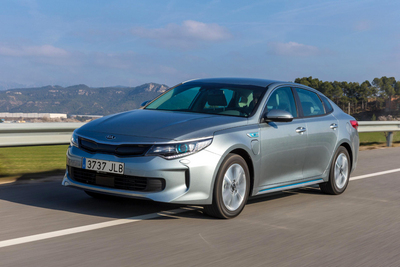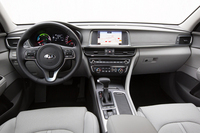Kia To Unveil Optima Plug-In Hybrid at 2016 Geneva Motor Show
 |
IN CONTEXT: Plug-in Hybrids 2002-Present
The Next Step In Kia's ‘Green’ Car Revolution
 |
The all-new Optima Plug-in Hybrid, Kia’s first ever plug-in hybrid electric vehicle, will receive its European premiere at next month’s Geneva Motor Show, ahead of the car going on sale across Europe in Q4 2016. The innovative new plug-in hybrid powertrain will be a key addition to Kia’s D-segment Optima line-up, as well as the company’s expanding portfolio of low-emission vehicles.
The all-new Optima Plug-in Hybrid provides greater battery capacity and pure electric range than earlier Optima Hybrid models, enabling drivers to travel up to 33 miles in zero-emissions electric-only mode before the efficient 2.0-litre GDI (gasoline direct injection) engine is required to provide propulsion. Kia’s development teams are targeting combined CO2 emissions of just 37 g/km, which will ensure a low total cost of ownership for private and fleet buyers alike.
Michael Cole, Chief Operating Officer, Kia Motors Europe, commented: “Hybrid sales have more than doubled in Europe over the last five years, and are estimated to account for around 700,000 new car sales in Europe by 2020. The Optima Plug-in Hybrid will allow Kia to address the growing demand for low-emissions vehicles, and support us in our mission to hit our global 2020 target: to improve average fleet fuel efficiency by 25% over 2014 levels.”
He added, “Our advanced new Plug-in Hybrid powertrain makes the Optima an incredibly compelling proposition for private and fleet customers. It combines attractive design, a great driving experience, low running costs and minimal environmental impact.”
The last-generation Kia Optima is credited with starting the brand’s design-led transformation when it was launched globally in 2010. The all-new Optima marks the next stage in this transformation, with the new Plug-in Hybrid model featuring a series of visual enhancements. These changes differentiate the model from other Optima models powered by conventional internal combustion powertrains, and also improve aerodynamic efficiency.
The all-new Optima Plug-in Hybrid comes equipped with a series of intuitive driver assistance technologies, maximising safety and further contributing to efficient engine performance.
33 mile electric-only range and 37 g/km CO2emissions development
target
The Optima Plug-in Hybrid is powered by a 9.8 kWh lithium-polymer
battery pack paired with a 50 kW electric motor, allowing it to operate in
pure-electric mode for up to 33 miles at speeds as high as 120 kph, placing
the Optima Plug-in Hybrid among the leaders in the D-segment for
pure-electric range.
The innovative powertrain employs Kia’s efficient 2.0-litre ‘Nu’ four-cylinder GDI engine at its core, which on its own generates156 ps and 189 Nm. The engine is coupled with the electric motor, which allows the car to operate in charge-sustaining mode once the battery runs out of charge. The powertrain’s total power output is 205 ps at 6,000 rpm, with the application of the electric motor facilitating immediate engine response to throttle inputs. With the addition of electric power, the Plug-in Hybrid’s total torque output is a high 375 Nm (276lb ft) from just 2,300 rpm.
Power is applied to the road through a smooth-shifting six-speed automatic gearbox, with the transmission-mounted 50 kW electric motor that is used to power the Optima Plug-in Hybrid replacing the traditional torque converter.
The Optima Plug-in Hybrid’s next-generation battery system features a 9.8 kWh lithium-ion polymer battery pack, which produces significantlymore energy output than the battery pack found in the outgoing Optima’s hybrid system. Its simplicity enables compact packaging on the front axle, and a straightforward provision of electric and petrol power to the driven front wheels with minimal energy transfer and conversion losses.
The Optima Plug-in Hybrid offers a seamless blend of highly-efficient electric and internal combustion power, and a consistently high level of performance. The Optima Plug-in Hybrid will accelerate from 0-to-100 kph in 9.4 seconds, 0.6 seconds faster than the previous-generation parallel hybrid, the Optima Hybrid.
The Optima Plug-in Hybrid is expected to deliver carbon dioxide emissions of 37 g/km (combined, New European Driving Cycle).
In spite of the space taken up by the high-capacity battery pack, the Optima Plug-in Hybrid is packaged in such a way to allow a 307-litre (VDA) cargo capacity, with the new battery pack hidden behind the rear seat and in the tyre well. The addition of the plug-in powertrain means engineers have been able to fit a smaller fuel tank than the outgoing Optima Hybrid, with capacity reduced from 65 to 55 litres.
Aesthetic and aerodynamic enhancements instantly distinguishable
In exterior profile, the Optima Plug-in Hybrid is instantly recognisable
as a Kia and as part of the Optima family, although it adopts a range of
enhancements that further improve aerodynamic efficiency. When the
car’s all-new active air flap grille is activated, Kia’s design
teams have reduced the drag coefficient to just 0.25 Cd (0.27 Cd for the
Optima sedan). Reprofiled front and rear bumpers enable more efficient
air-flow over the body of the car, thanks to a more aerodynamically
efficient design.
Also distinguishing the Optima Plug-in Hybrid is special chrome trim with a clean metallic blue finish, for the rear bumper, grille surround and wheel arches, as well as special ‘EcoPlugin’ badging. The charging port is integrated into the driver-side front wing.
 |
Inside, the Optima Plug-in Hybrid features a series of enhancements to reflect the innovative nature of the car and its powertrain. A new driver instrument cluster displays key information about the Plug-in Hybrid powertrain – such as the battery’s state of charge – as well as details on driving style, highlighting where a driver can drive more efficiently.
New touchscreen infotainment system with Android Auto™ and Apple
CarPlay™
The Optima Plug-in Hybrid is equipped with Kia’s latest
audio-visual navigation (AVN) functionality, with an 8.0-inch touchscreen
infotainment system. DAB digital radio, which is available across a number
of European markets, is fully supported with Kia’s AVN. New for the
Plug-in Hybrid, the AVN features a series of menus to show the car’s
current EV range, as well as a new function to locate nearby charging
stations.
The Optima Plug-in Hybrid will additionally be among first Kia models to feature Android Auto™, designed to work with Android phones running 5.0 (Lollipop) or higher, and Apple CarPlay™ for iPhone 5 or newer. Both systems feature voice control and allow the driver to keep their hands on the wheel and eyes on the road ahead at all times.
Available from launch, Android Auto™ connects to the user’s phone and lets them access smartphone apps and functions through the in-car infotainment system, such as voice-guided Google Maps navigation, hands-free calls and texts and voice recognition. Android Auto™ also lets users stream music from Google Play Music.
Apple CarPlay™ – available on Plug-in Hybrid Models by the end of 2016 – will enable full Siri voice control to control the phone’s various functions and apps, including navigation via Apple Maps, calls and text dictation. Apple CarPlay™ also supports other audio apps, such as music streaming or audiobooks, that the user may have downloaded to their iPhone.
The AVN system offers a full Kia Connected Services package, with up-to-date, driver-oriented information. Provided by technology company TomTom, the broad range of available connectivity features includes live traffic updates, speed camera alerts, local search and weather forecasts. In Europe, the system will be available to Optima Plug-in Hybrid buyers free of charge for seven years after the car’s purchase.
The touchscreen infotainment system is paired with a six-speaker audio system as standard, while music lovers can also specify a powerful 590-watt Harman Kardon QuantumLogic™ Premium Sound Audio System, with 10 speakers, an external amplifier, Clari-Fi MP3 restoration technology and Harman Kardon’s advanced QuantumLogic surround sound technology.
The Optima Plug-in Hybrid is available with Kia’s new wireless charger for mobile devices, situated at the base of the central console. The 5W wireless charger lets users charge their phone on the move, without plugging in. With ‘foreign object detection’, the charging system activates when a compatible device is placed on the pad and warns owners when they’ve left a phone on the charger when they leave the vehicle. The system displays the phone’s charging condition on the instrument cluster, and features a safety system to prevent overheating while in use.
Intelligent fuel-saving and energy harvesting technologies for efficient battery use The all-new Optima Plug-in Hybrid comes equipped with a series of innovations to enhance the efficiency of the battery pack, as well as advanced energy harvesting systems and driver assistive technologies.
The Optima Plug-in Hybrid is equipped with two key technologies to save and regenerate battery power – regenerative braking and a new Coasting Guide Control (CGC) function. The Optima Plug-in Hybrid is also equipped with an advanced heating, ventilation and air conditioning (HVAC) system with a driver-only ventilation function to conserve energy.
Kia’s regenerative braking system – now in its third-generation for its application in the Optima Plug-in Hybrid effectively allows the car to harvest kinetic energy while coasting or braking. Updated over the system found in earlier iterations of the Optima Hybrid, the new system is able to regenerate 11% more energy, recharging the Plug-in Hybrid’s battery when possible to reduce emissions and improve hybrid driveability.
Adopted from the Kia Soul EV, the Optima Plug-in Hybrid features Kia’s advanced HVAC system, which employs a smart air intake system with a ‘Driver Only’ ventilation system. This individual ventilation system provides ventilation and heating to the driver’s seat, completely shutting off heating and ventilation to other areas of the car. This is in contrast to other systems, in which closing the vents merely diverts ventilation through other vents in the car while energy consumption remains the same. Overall, the HVAC system seeks to reduce the load on the battery and cut energy consumption from heating and ventilation.
High strength bodyshell and active safety assistance technologies
The Optima Plug-in Hybrid offers a high level of safety from its
lightweight, high-strength body and high levels of passive and active
safety, with the maximum possible five-star Euro NCAP safety rating.
The bodyshell of the Optima Plug-in Hybrid benefits from the extensive application of Advanced High-Strength Steel (AHSS), which makes up 51% of the body. AHSS has been used to reinforce the car’s A and B-pillars, side sills, roof, floor pan and front wheel arches.
Inside the strong bodyshell, passive occupant safety is assured with driver, driver knee, passenger, two front side and two curtain airbags all fitted as standard.
The Kia Optima Plug-in Hybrid remains a strong performer in Euro NCAP’s increasingly important Safety Assist category thanks to its suite of active safety technologies designed to avoid or mitigate the effects of a collision.
Kia’s Vehicle Stability Management (VSM) is fitted as standard, ensuring stability under braking and cornering by controlling the car’s Electronic Stability Control (ESC) and electric motor-driven power steering if it detects a loss of traction.
The Optima Plug-in Hybrid is available with a wide range of optional active hazard-avoidance technologies, depending on market. These include:
◾ Advanced Smart Cruise Control (SCC), which automatically adjusts the Optima’s speed to maintain a safe distance from vehicles in front
◾ Autonomous Emergency Braking (AEB)*, which employs a long-range radar detection system to detect a potential collision with another vehicle or pedestrian and help bring the car to a halt
◾ Lane Keeping Assist System (LKAS), which detects the Optima’s position in relation to lane markings and takes automatic corrective action if it senses the car starting to draft without the use of indicators
◾ High Beam Assist (HBA), which automatically adjusts headlamp range according to other vehicles and road conditions
◾ Speed Limit Information Function (SLIF), displaying the speed limit in the driver’s instrument cluster based on cameras detecting roadside signs
◾ Blind Spot Detection (BSD), with a visual warning in the door mirror when another car enters the driver’s blind spot
◾ Rear Cross Traffic Alert (RCTA), which warns against other cars driving behind the Optima in car parks while reversing.
The Optima Plug-in Hybrid’s AEB system is unique in its segment in Europe for offering not just a short-range radar, but also a longer-range radar unit which is able to identify cars and pedestrians further away and at higher speeds than many competitors.
The short-range ‘City’ radar helps drivers avoid or mitigate the effects of front collisions when travelling under 50 kph, while the longer-range ‘Urban’ radar enables the Optima to detect and respond to obstacles at speeds between 30 and 80 kph. The AEB system’s pedestrian-detection function is designed to identify pedestrians when travelling up to 60 kph and reduce the risk of a collision.
*The Autonomous Emergency Braking System (AEBS) is an assistance system and does not relieve the driver from his/her responsibility to safely operate the vehicle at any time. The driver still has to adapt his/her driving behaviour to his/her personal driving capabilities, to the legal requirements and to the overall road and traffic conditions. AEBS is not designed to drive the vehicle autonomously. For further information, please refer to the owner’s manual.
Sharp handling and larger brakes With a light, rigid chassis, the Optima Plug-in Hybrid’s suspension is well equipped to isolate vibrations and bumps from poor road surfaces, while the fine-tuned, fully-independent suspension set-up blends agile handling with an improvement in ride comfort compared to the car’s predecessor, the Optima Hybrid.
The Optima Plug-in Hybrid carries over the same suspension hardware from the base Optima sedan, ensuring high ride comfort and engaging handling, while the spring, damper and alignment settings have been tuned specially for the Plug-in Hybrid model, in order to manage the additional weight of the powertrain.
The Optima Plug-in Hybrid is equipped with Kia’s column-mounted electric motor-driven power steering system (C-MDPS), for predictable and linear responses to driver inputs. Larger disc brakes at the rear of the car compared to conventionally-powered Optima models (300 mm in diameter for the Plug-in Hybrid, up from 262 mm) ensure braking performance remains high in spite of the additional weight of the Plug-in Hybrid powertrain.
2016 Kia Optima Plug-in Hybrid on-sale from Q4 2016
The all-new Kia Optima Plug-in Hybrid will go on sale across Europe in
Q4 2016, offering the company’s unique 7-Year, 100,000 mile warranty
as standard. The all-new Optima Plug-in Hybrid for Europe will be built at
Kia’s plant in Hwasung, Korea.


